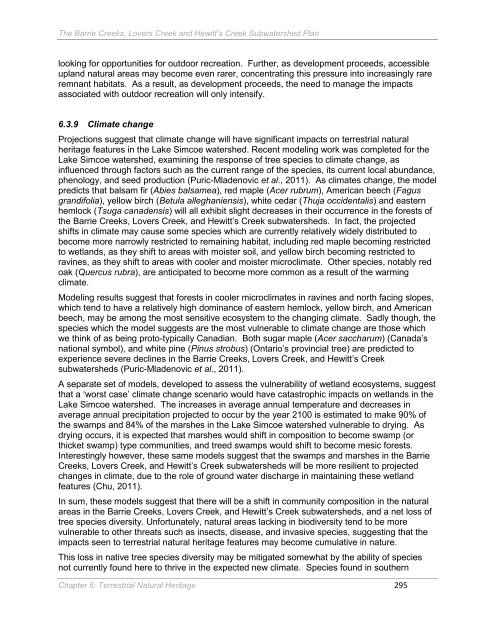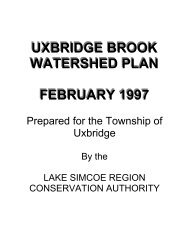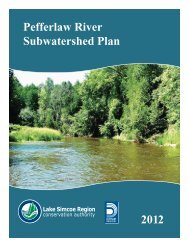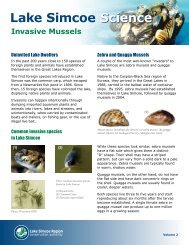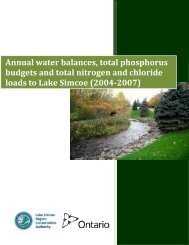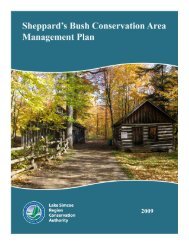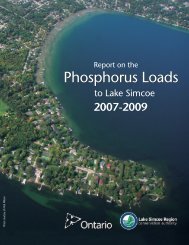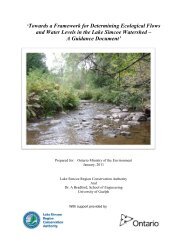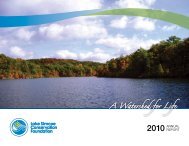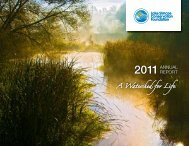Barrie Creeks, Lovers Creek, and Hewitt's Creek Subwatershed Plan
Barrie Creeks, Lovers Creek, and Hewitt's Creek Subwatershed Plan
Barrie Creeks, Lovers Creek, and Hewitt's Creek Subwatershed Plan
Create successful ePaper yourself
Turn your PDF publications into a flip-book with our unique Google optimized e-Paper software.
The <strong>Barrie</strong> <strong><strong>Creek</strong>s</strong>, <strong>Lovers</strong> <strong>Creek</strong> <strong>and</strong> Hewitt’s <strong>Creek</strong> <strong>Subwatershed</strong> <strong>Plan</strong><br />
looking for opportunities for outdoor recreation. Further, as development proceeds, accessible<br />
upl<strong>and</strong> natural areas may become even rarer, concentrating this pressure into increasingly rare<br />
remnant habitats. As a result, as development proceeds, the need to manage the impacts<br />
associated with outdoor recreation will only intensify.<br />
6.3.9 Climate change<br />
Projections suggest that climate change will have significant impacts on terrestrial natural<br />
heritage features in the Lake Simcoe watershed. Recent modeling work was completed for the<br />
Lake Simcoe watershed, examining the response of tree species to climate change, as<br />
influenced through factors such as the current range of the species, its current local abundance,<br />
phenology, <strong>and</strong> seed production (Puric-Mladenovic et al., 2011). As climates change, the model<br />
predicts that balsam fir (Abies balsamea), red maple (Acer rubrum), American beech (Fagus<br />
gr<strong>and</strong>ifolia), yellow birch (Betula alleghaniensis), white cedar (Thuja occidentalis) <strong>and</strong> eastern<br />
hemlock (Tsuga canadensis) will all exhibit slight decreases in their occurrence in the forests of<br />
the <strong>Barrie</strong> <strong><strong>Creek</strong>s</strong>, <strong>Lovers</strong> <strong>Creek</strong>, <strong>and</strong> Hewitt’s <strong>Creek</strong> subwatersheds. In fact, the projected<br />
shifts in climate may cause some species which are currently relatively widely distributed to<br />
become more narrowly restricted to remaining habitat, including red maple becoming restricted<br />
to wetl<strong>and</strong>s, as they shift to areas with moister soil, <strong>and</strong> yellow birch becoming restricted to<br />
ravines, as they shift to areas with cooler <strong>and</strong> moister microclimate. Other species, notably red<br />
oak (Quercus rubra), are anticipated to become more common as a result of the warming<br />
climate.<br />
Modeling results suggest that forests in cooler microclimates in ravines <strong>and</strong> north facing slopes,<br />
which tend to have a relatively high dominance of eastern hemlock, yellow birch, <strong>and</strong> American<br />
beech, may be among the most sensitive ecosystem to the changing climate. Sadly though, the<br />
species which the model suggests are the most vulnerable to climate change are those which<br />
we think of as being proto-typically Canadian. Both sugar maple (Acer saccharum) (Canada’s<br />
national symbol), <strong>and</strong> white pine (Pinus strobus) (Ontario’s provincial tree) are predicted to<br />
experience severe declines in the <strong>Barrie</strong> <strong><strong>Creek</strong>s</strong>, <strong>Lovers</strong> <strong>Creek</strong>, <strong>and</strong> Hewitt’s <strong>Creek</strong><br />
subwatersheds (Puric-Mladenovic et al., 2011).<br />
A separate set of models, developed to assess the vulnerability of wetl<strong>and</strong> ecosystems, suggest<br />
that a ‘worst case’ climate change scenario would have catastrophic impacts on wetl<strong>and</strong>s in the<br />
Lake Simcoe watershed. The increases in average annual temperature <strong>and</strong> decreases in<br />
average annual precipitation projected to occur by the year 2100 is estimated to make 90% of<br />
the swamps <strong>and</strong> 84% of the marshes in the Lake Simcoe watershed vulnerable to drying. As<br />
drying occurs, it is expected that marshes would shift in composition to become swamp (or<br />
thicket swamp) type communities, <strong>and</strong> treed swamps would shift to become mesic forests.<br />
Interestingly however, these same models suggest that the swamps <strong>and</strong> marshes in the <strong>Barrie</strong><br />
<strong><strong>Creek</strong>s</strong>, <strong>Lovers</strong> <strong>Creek</strong>, <strong>and</strong> Hewitt’s <strong>Creek</strong> subwatersheds will be more resilient to projected<br />
changes in climate, due to the role of ground water discharge in maintaining these wetl<strong>and</strong><br />
features (Chu, 2011).<br />
In sum, these models suggest that there will be a shift in community composition in the natural<br />
areas in the <strong>Barrie</strong> <strong><strong>Creek</strong>s</strong>, <strong>Lovers</strong> <strong>Creek</strong>, <strong>and</strong> Hewitt’s <strong>Creek</strong> subwatersheds, <strong>and</strong> a net loss of<br />
tree species diversity. Unfortunately, natural areas lacking in biodiversity tend to be more<br />
vulnerable to other threats such as insects, disease, <strong>and</strong> invasive species, suggesting that the<br />
impacts seen to terrestrial natural heritage features may become cumulative in nature.<br />
This loss in native tree species diversity may be mitigated somewhat by the ability of species<br />
not currently found here to thrive in the expected new climate. Species found in southern<br />
Chapter 6: Terrestrial Natural Heritage 295


